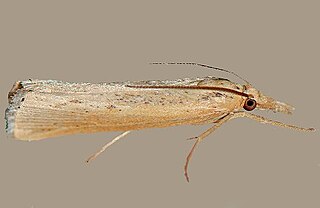Mimoschinia is a genus of moths of the family Crambidae. It contains only one species, Mimoschinia rufofascialis, the rufous-banded pyralid moth or barberpole caterpillar, which is found in the Caribbean, from Alberta to British Columbia, south to Texas and California and in Mexico.
Mojaviodes is a genus of moths of the family Crambidae. It contains only one species, Mojaviodes blanchardae, which is found in North America, where it has been recorded from Texas.
Nannobotys is a genus of moths of the family Crambidae. It contains only one species, Nannobotys commortalis, which is found in North America, where it has been recorded from eastern Washington to California and Nevada.
Neargyrioides is a genus of moths of the family Crambidae. It contains only one species, Neargyrioides aglaopis, which is found in Australia, where it has been recorded from the Northern Territory and Queensland.
Nechilo is a genus of moths of the family Crambidae. It contains only one species, Nechilo macrogona, which is found in Australia, where it has been recorded from Victoria.
Neocataclysta is a genus of moths of the family Crambidae. It contains only one species, Neocataclysta magnificalis, the scrollwork pyralid moth, which is found in North America, where it has been recorded from Florida, Georgia, Maine, Massachusetts, Mississippi, New Jersey, New York, North Carolina, Nova Scotia, Ohio, Ontario and South Carolina.
Neocymbopteryx is a genus of moths of the family Crambidae. It contains only one species, Neocymbopteryx heitzmani, which is found in North America, where it has been recorded from Arkansas.
Nyctiplanes is a genus of moths of the family Crambidae. It contains only one species, Nyctiplanes polypenthes, which is found in Australia, where it has been recorded from Queensland.
Nymphuliella is a monotypic moth genus of the family Crambidae described by William Harry Lange in 1956. It contains only one species, Nymphuliella daeckealis, known in the US as the china mark moth, described by F. Haimbach in 1915. It is found in the United States from New Jersey south to Florida and west to Colorado.
Odontivalvia is a genus of moths of the family Crambidae. It contains only one species, Odontivalvia radialis, which is found in North America, where it has been recorded from Texas.
Pseudoschoenobius is a genus of moths of the family Crambidae. It contains only one species, Pseudoschoenobius opalescalis, which is found in North America, where it has been recorded from Alberta, Illinois, Indiana, New Mexico and California. The habitat consists of dry, sandy areas.

Pseudoschinia is a genus of moths of the family Crambidae. It contains only one species, Pseudoschinia elautalis, which is found in North America, where it has been recorded from Arizona, California, Nevada, New Mexico and Texas.
Paracorsia is a monotypic moth genus of the family Crambidae described by H. Marion in 1959. It contains only one species, Paracorsia repandalis, described by Michael Denis and Ignaz Schiffermüller in 1775. It is found in most of Europe, except Ireland, Fennoscandia and the Baltic region. It has also been recorded from central Asia, including Iran and Kyrgyzstan and North America where it has been recorded in southern Ontario and northern Indiana.
Paregesta is a genus of moths of the family Crambidae. It contains only one species, Paregesta californiensis, which is found in North America, where it has been recorded from California.
Plumipalpiella is a genus of moths of the family Crambidae. It contains only one species, Plumipalpiella martini, which is found in North America, where it has been recorded from California.
Porphyrorhegma is a genus of moths of the family Crambidae. It contains only one species, Porphyrorhegma fortunata, which is found in North America, where it has been recorded from California.
Portentomorpha is a genus of moths of the family Crambidae. It contains only one species, Portentomorpha xanthialis, which is found from Texas to Louisiana and Florida, the West Indies and from Mexico to Bolivia.
Raphiptera is a genus of moths of the family Crambidae. It contains only one species, Raphiptera argillaceellus, the diminutive grass-veneer, which is found in eastern North America, where it has been recorded from Labrador, Ontario, Wisconsin, Connecticut, New York, Quebec, Alberta and Michigan. The range extends to Florida and Texas in the south-east and Costa Rica in Central America. The habitat consists of bogs.

Sclerocona is a genus of moths of the family Crambidae which contains only one species, Sclerocona acutella. It was first described by the Prussian biologist Eduard Friedrich Eversmann in 1842.

Tehama is a genus of moths of the family Crambidae. It contains only one species, Tehama bonifatella, the western lawn moth, which is found in Greenland and North America, where it has been recorded from Alberta, British Columbia, California, Colorado, Labrador, Manitoba, Nevada, Quebec and Washington. The habitat consists of grasslands.



